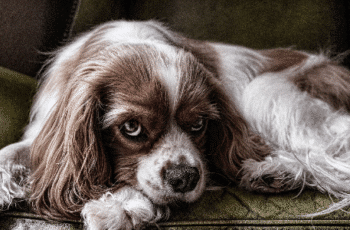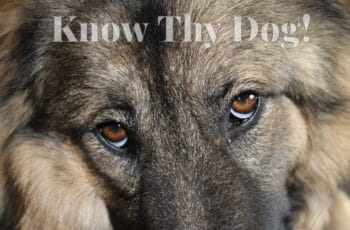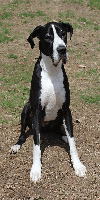 The Great Dane is a large German breed of domestic dog commonly referred to as a German Mastiff, originally bred for hunting wild boars. The name mastiff is often confusing because it refers to several breeds of quite different sizes. The Great Dane got its name from Germany’s famous national symbol, the majestic white stallion, because of its great size. The breed can be viewed as large and heavy-set with a balanced masculine appearance. Its coat is usually solid black and coarse, but a gray pattern may be present in some dogs. The Great Dane was used by royalty for hunting boars and bears, but it was widely used for cattle and sheepherding as well.
The Great Dane is a large German breed of domestic dog commonly referred to as a German Mastiff, originally bred for hunting wild boars. The name mastiff is often confusing because it refers to several breeds of quite different sizes. The Great Dane got its name from Germany’s famous national symbol, the majestic white stallion, because of its great size. The breed can be viewed as large and heavy-set with a balanced masculine appearance. Its coat is usually solid black and coarse, but a gray pattern may be present in some dogs. The Great Dane was used by royalty for hunting boars and bears, but it was widely used for cattle and sheepherding as well.
The Great Dane is a huge dog that weighs up to 200 pounds. Its skin folds over it like a large blanket, making it look even larger. It has a huge head, and its nose is long, narrow, and black. The Great Dane’s eyes are slightly slanted and are of medium size. It has a robust build, both in its shoulders and chest. Its legs are short but not stubby. These dogs have strong bone structures typical of other hounds. Males can weigh, and females can weigh more.
It has a square muzzle with an overbite. The ears are held erect and variable in shape, but they are always large and floppy. The tail is long (up to ) and hangs low. The coat is short but dense, soft, curly, and woolly in texture. There are three colors: black, brindle (grayish-brown with black markings), or red. Black is the most common color. The Great Dane has a large head with a powerful jaw. There are two variants: one with a square muzzle and one with a more rounded muzzle.
The only permissible colors for the Great Dane are black, harlequin (white base with black torn patches), brindle, or fawn (Isabella) – all of which have black masks.
Great Danes have solid and energetic personalities that make them easy to train and love people. They don’t have much facial expression with their large head, but once they become comfortable around you and your family, they will be very calm and gentle when picked up or petted. Great Danes know their own strength and can be very territorial towards other animals or people.
Great Danes are gentle with children, but they should be supervised around young children to prevent accidental injury like all dogs. Great Danes reach full physical maturity at 24 months (or up to 2 years for females).
 Female Danes are in heat once a year between January and February. The male Dane is usually not fertile before six months of age, and sometimes not until 12 months. The average litter size is four to six puppies; it is rare for them to have more than eight. The puppies are quite large at birth, about a quarter the size of an adult dog. They learn to bark at about four weeks and can control their bladder after two months. They will be ready to leave their mothers between four and five months old, although some breeders take as long as eight months before letting them go.
Female Danes are in heat once a year between January and February. The male Dane is usually not fertile before six months of age, and sometimes not until 12 months. The average litter size is four to six puppies; it is rare for them to have more than eight. The puppies are quite large at birth, about a quarter the size of an adult dog. They learn to bark at about four weeks and can control their bladder after two months. They will be ready to leave their mothers between four and five months old, although some breeders take as long as eight months before letting them go.
The Great Dane is a very peaceful breed that gets along with other dogs and even other animals such as rabbits if appropriately socialized.
Great Danes are naturally dominant and usually not the best choice for a first-time dog owner. The Great Dane is calm, tolerant, and kind. It is commonly referred to as the “Apollo of Dogs” because of its stately appearance. This breed needs well-exercised daily, as they are prone to obesity and lazy habits.
Origins: The Great Dane traces its ancestry back to the Roman Empire, used for dogfighting and hunting wild boar. Later, the breed was used to guard wealth and to catch robbers. The Great Dane was popular in Germany until the late 19th century.
Temperament: The Great Dane is a calm yet alert breed of dog, and it has a well-mannered and kind personality. Although this breed is generally considered gentle, they can be aggressive toward other animals they perceive as threats. The Great Dane also becomes angry when it feels threatened or cornered.
Coat: The Great Dane also has a thick double coat. Its undercoat contains longer and softer hair that keeps the dog warm during winter. The upper coat consists of hard, straight, long guard hairs that protect it against the cold wind and rain; however, it quickly loses its hair during summers.
Height: The Great Dane can be a tall breed of dog ranging from 21–27 inches at the shoulder to 58–75 pounds for a small dog. These dogs are usually 20 to 24 inches in height and weigh between 70 and 100 pounds.
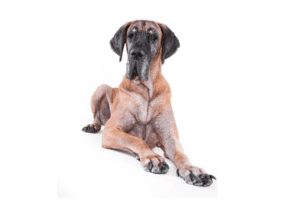 Life Expectancy: On average, the Great Dane lives about 7 to 10 years. However, they have been known to live as long as 13 years; however, this is rare. There are also cases when these dogs have died at the age of 6 months; therefore, no accurate conclusion can be drawn about its life span.
Life Expectancy: On average, the Great Dane lives about 7 to 10 years. However, they have been known to live as long as 13 years; however, this is rare. There are also cases when these dogs have died at the age of 6 months; therefore, no accurate conclusion can be drawn about its life span.
The Great Dane does not have the highest lifespan among dogs, but it can live up to 12 years old in good health. The Great Dane suffers from one common disease: hip dysplasia, a hip joint problem. The Great Dane is susceptible to several other health problems: canine elbow dysplasia (CD), cataracts, Legg-calve-perianal disease, progressive retinal atrophy (PRA), hypothyroidism, diabetes mellitus, and epilepsy.
The Great Dane should be given a high-quality dry dog food that contains at least 24% protein. It also requires nutrients such as calcium, phosphorous, and vitamins A & D for strong bones and teeth. Most commercial dog food manufacturers produce some quality products for large breed dogs, including the Great Dane.
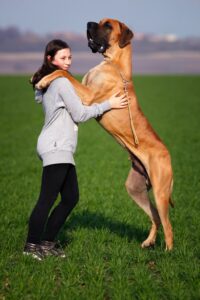 Environment: The Great Dane is an energetic breed of dog that can live in an apartment or a house. It does not require much space, but it does have an urge to run and play. In some instances, the Great Dane owner might have to be in a large house with a reasonably large yard due to its size.
Environment: The Great Dane is an energetic breed of dog that can live in an apartment or a house. It does not require much space, but it does have an urge to run and play. In some instances, the Great Dane owner might have to be in a large house with a reasonably large yard due to its size.
Playing: The Great Dane is a high-energy dog that loves to run and play. Due to its size, it is not suitable for playing with smaller dogs. It is very intelligent and social, but it does not interact well with other animals or small children. Its size means that it needs space and won’t do well in an apartment or a house without space for running around in the yard.
Lifestyle: The Great Dane is not recommended for families with young children. It is a large, active dog that requires plenty of exercises every day. This breed tends to jump into the laps of its owner and children; therefore, it needs to be taught from an early age to jump on its own bed or couch instead of people’s laps.
Training: The Great Dane is an intelligent dog that can be trained easily if the owner is firm and consistent. Since it is prone to jumping on people, it should be trained from a very early age to remain calm when greeting people and other dogs. If the dog owner knows who will be at the house, he can keep the dog on its leash until that person comes in to avoid large amounts of jumping.
The dog owner must be very firm and consistent with keeping its behavior obedient and well-mannered. Without proper obedience training, this dog can become aggressive in the house and try to bite people who approach it.
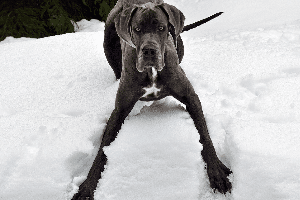 Activity: The Great Dane is a very active dog. It needs regular exercise every day. It is recommended to take it running, for example, or do other activities to run and get some exercise. This is especially important when the dog is young; otherwise, it may become overweight and develop health conditions. The exercise should always be monitored because this breed can get very moody if not given enough.
Activity: The Great Dane is a very active dog. It needs regular exercise every day. It is recommended to take it running, for example, or do other activities to run and get some exercise. This is especially important when the dog is young; otherwise, it may become overweight and develop health conditions. The exercise should always be monitored because this breed can get very moody if not given enough.
Living conditions: The Great Dane is a dog that can adapt to apartment life no problem, but it needs some space and plenty of exercise to be happy. If the owners want it to live outside of an apartment, then the dog must have a lot of room to move around and play and socialize with other dogs. This breed is not recommended for people living in an urban environment because it does not like being alone in a yard.
Source
https://en.wikipedia.org/wiki/Great_Dane#Health_and_longevity
http://www.dogbreedinfo.com/Great_Dane_Dog.html
https://greatdaneclubofamerica.org/facts-about-great-danes/
http://www.merckmanuals.com/vet/general_surgery/orthopedic_surgery/great_dane’s_.html#v20039067
https://www.aspca.org/pet-care/virtual-pet-behaviorist/dog-behavior/great-dane

